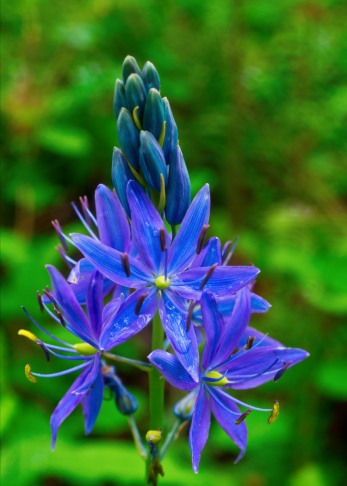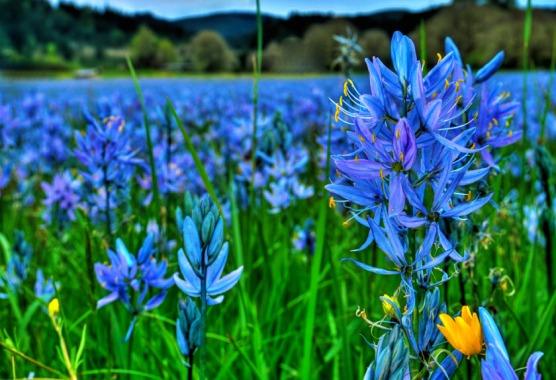In many areas of the Willamette Valley, and numerous other northwest locations, Mother Nature will soon produce a magic show that has left audiences in awe for over 200 years. Meriwether Lewis recorded his observation of this phenomenon after bearing witness in 1806 when he wrote: “from the color of its bloom at a short distance it resembles lakes of fine clear water, so complete in this deception that on first sight I could have sworn it was water.”

Over 200 years later the beauty of the camas flower hasn’t diminished a bit, although its habitat has decreased significantly. A number of species and subspecies of blue and white camas, members of the lily family, are found throughout Oregon from the Pacific shore to the remote reaches of Hell’s Canyon. Camas is found in many areas of North America, with Oregon home to the largest number of camas species.
In addition to its natural beauty, camas was a major component of the diet of the native people. The bulbs were typically cooked in earthen pits for 36 to 48 hours, the time required to transform inulin found in raw camas into fructose. Camas cakes, which were produced when baked camas was left to dry, were stored for consumption in the winter months or used for trade with neighboring tribes. The Nez Perce shared bulbs with members of the Lewis and Clark Expedition in 1805, rescuing the party from near starvation. Except for varieties of dried salmon, no other food item was more widely traded. These desirable roots were also traditionally shared at tribal marriages and funerals.
Camas flowers were a common sight from April to June in wet prairies, meadows, oak savannas, and streambeds of the northwest prior to the influx of Euro-Americans in the early 1800s. Camas thrives in wet places that dry out later in the summer.
The Willamette Valley was once home to nearly one million acres of prime camas habitat, and the Kalapuya people maintained it by selectively burning parts of it each fall to keep grasses and under-growth to a minimum. They also rotated the harvest areas annually to allow for regeneration of the crop to assure a perpetual supply.
The arrival of Oregon Trail immigrants changed the fate of not only the native inhabitants but also their way of life. The federal government took their best land and herded the natives onto reservations, usually the least desirable land available. Livestock, including cows, horses, sheep, and pigs destroyed the camas habitat, as did cultivating the meadows for agricultural uses. In some instances the indigenous residents were able to negotiate access to the camas grounds during harvest season. But not always.
The Bannock Indian War of 1878 was all about camas. The U.S. government reneged on the terms of a treaty agreement drafted in 1868 in Fort Bridger, Wyo. with the Bannock and Shoshone Indians. The terms of the treaty allowed for the formation of a second reservation at Great Camas Prairie in addition to the grounds at Fort Hall, yet those terms were never addressed. The Bannocks were denied the opportunity to gather provisions for winter and trade when they were prohibited from harvesting roots at Great Camas Prairie southeast of Boise.
By 1877 the conditions at Fort Hall were unbearable as provisions furnished by the U.S. government as terms of the treaty were meager in the best of times. The Bannocks and Shoshones were starving. To alleviate the hunger, members of the tribes left the reservation to travel to Great Camas Prairie to harvest camas for the upcoming winter, and found that much of the prairie had been destroyed by the hooves of cattle and pigs.
The animosity between the natives and immigrants grew increasingly tense, fueled by editorial rhetoric from the Idaho Statesman newspaper, which printed the following editorial during this particularly apprehensive time: “This would be our plan of establishing friendship on an eternal basis with our Indians: Let all the hostile bands of Idaho Territory be called in (they will not be caught in any other manner) to attend a grand treaty; plenty of blankets and nice little trinkets distributed among them; plenty of grub on hand; have a jolly time with them; then just before the big feast put strychnine in their meat and poison to death the last mother’s son of them.”
The U.S. government once again turned a deaf ear to their needs, which led Bannock chief Buffalo Horn and about 200 Bannock, along with a number of Paiute warriors, to go to war against the United States. After a number of clashes between the warriors and the U.S. Army that led from Idaho into the Malheur region of southeast Oregon to the Yellowstone area of Wyoming, the surviving Bannocks and Paiutes surrendered and were returned to their reservations.
General George Crook, a career officer in the US Army and namesake of Crook County in eastern Oregon, stated in an interview with the Omaha Herald about the Bannock War: ”It cannot be expected that they will stay on reservations where there is no possible way to get food, and see their wives and children starve and die around them. We have taken their lands, deprived them of every means of living.”
The importance of camas was not lost as a number of geographic locations in Oregon, Washington, and Idaho preserve the name of this important crop that signified away of life. Numerous valleys, swales, streams, several towns, and a county all bear witness to the staple of life for the Native Americans.
The Camas Pocket Gopher derives its name from its favorite food and is reportedly only found in Western Oregon. The Nature Conservancy owns the Camissa Natural Area in West Linn, Oregon. Cammisa quamash is the Latin name for the common camas, the prevalent species in Oregon. The 27-acre preserve is home to over 400 species of native plants and wildlife.
Today, camas lilies are available as garden cultivars (plants selected for desirable characteristics that can be maintained by propagation). Wetland and prairie restoration efforts in Oregon, Washington, and British Columbia include the reintroduction of camas along with other native species. Tribal harvest celebrations in the Pacific Northwest commemorate the role of camas in their cultural history. Protecting native populations of camas has become critical since oak savannas and wetlands are rapidly being converted to housing, agriculture, and commercial development.

Despite the loss of habitat, fields of camas shimmering under the springtime sun still offer us a remarkable sight as fields are magically transformed into the breathtaking scene that Meriwether Lewis wrote of over 200 years ago. It’s astounding to visualize the significant role and number of people who died to protect access to this beautiful flower that played an amazing part of the history of our Pacific Northwest.
Published 2012

Inulin, not insulin
LikeLike
Auto correct strikes again…fixed it!
LikeLike